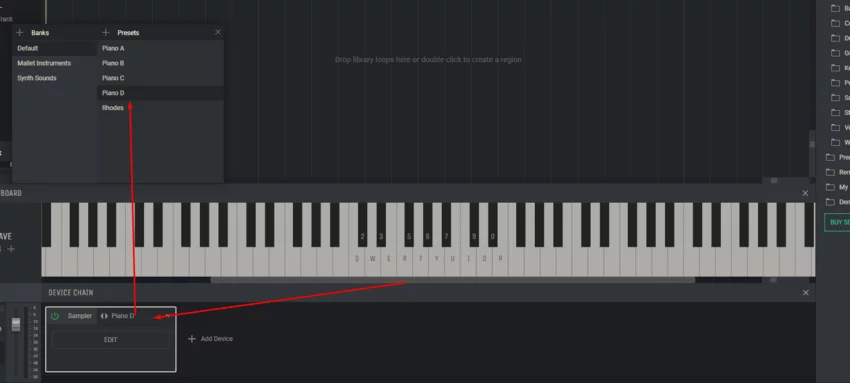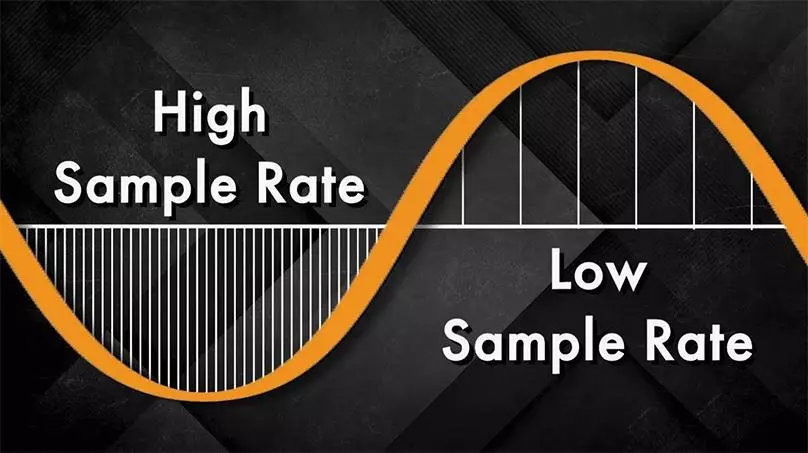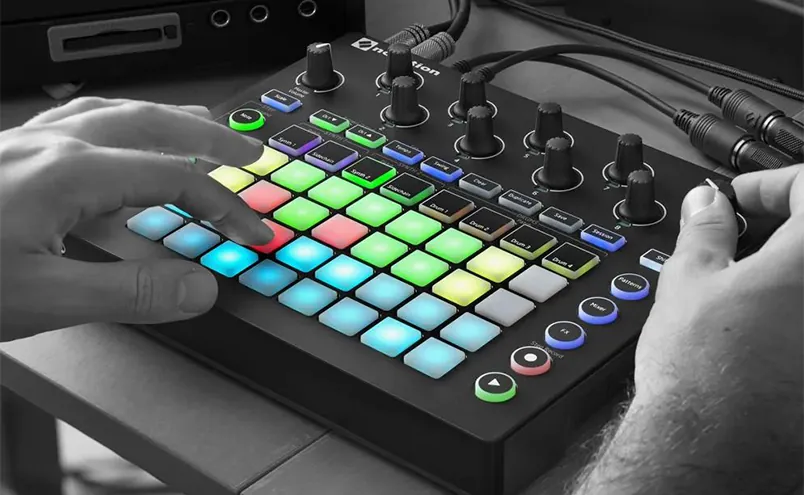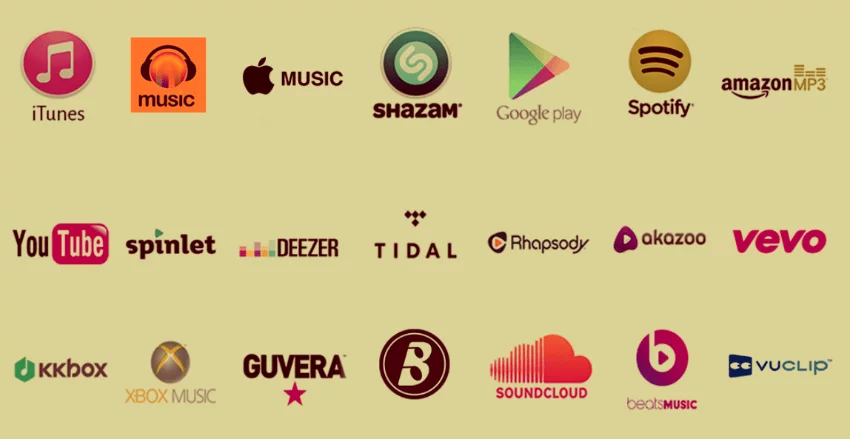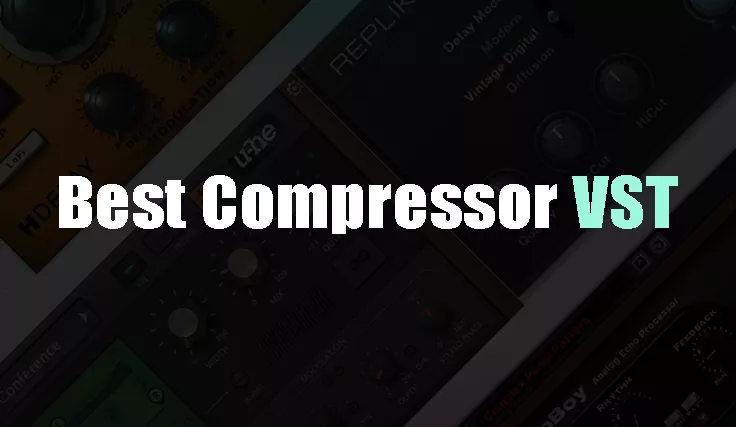Best midi keyboards

A MIDI controller keyboard is an essential piece of equipment in any studio. The best MIDI controllers can take your recordings to a whole new level. If you’re not sure where to start, we’ve got all the information you need right here.
USB-based MIDI controllers offer an easy and convenient way to play and record software instruments with your computer. They can be plugged directly into your PC or laptop via USB, or in some cases they can operate wirelessly over Bluetooth. This makes them a central performance hub for your studio, allowing you to play and record software instruments with ease. Some MIDI controllers also double up as a control interface for hardware synths, making them an essential piece of kit for any producer or musician.
There are a variety of different MIDI keyboards to choose from, depending on your needs. You can go for a smaller, more portable model that fits comfortably in a laptop bag, or you can go all out with a full-sized 88-note keyboard with weighted keys. The most important factors to consider include the number of keys (some models have 88 keys, while others have fewer), the type of action (weighted keys or not), and whether or not you need additional features such as knobs, pads, buttons and faders.
When shopping for a MIDI keyboard, it’s important to consider what you need in order to make the best purchase. You can get a cheap model for less than $100 if you look around, but if you’re looking for a higher quality option with more features, you’ll likely have to spend a bit more. In general, MIDI keyboards that cost more tend to be more rugged and able to stand up to travel. So, if you’re looking for something to take on the road with you, it might be worth spending a bit more.
Finding the right one for you can be a daunting task. With so many options available, it can be hard to know where to start. Our price comparison widgets have found the best deals online right now, so you can be sure you’re getting the best possible price. If you need more guidance, head to the buying advice section at the bottom of the page. There, you’ll find tips and advice on how to find the perfect product for your needs.
The list of the best midi keyboards – our choice
- Nektar SE25 MIDI keyboard
- Novation Launchkey Mini Mk3 MIDI keyboard
- Akai MPK Mini Mk3
- IK Multimedia iRig Keys 2 Mini
- Native Instruments Komplete Kontrol M32
- Korg microKEY2 Air-25
- M-Audio Oxygen 49 MKV
- Novation Launchkey 37 Mk3
- Arturia Keystep 37
- Native Instruments Komplete Kontrol A25
- IK Multimedia iRig Keys I/O 49
- Nektar Impact LX88+ MIDI keyboard
- Arturia Keystep Pro
- Arturia KeyLab 49 MkII MIDI keyboard
- Novation 49 SL MkIII
- Native Instruments Komplete Kontrol S61 MkII
- Roland A-88MKII
- ROLI Lumi Keys Studio Edition
- M-Audio Keystation 88 MK3
- M-Audio Oxygen MKV 61
- Nektar Impact GX Mini
- CME XKey 25
- Nektar Impact GX49/61
- M-Audio Keystation 49/61 MK3
- NI Komplete Kontrol A49
- Keith McMillen QuNexus
- Alesis V61
- Nectar SE49
- Roli Seaboard
MDI keyboard selection criteria
The best piano replacements don’t have to strictly follow the 88 weighted key rule. There are many great pianos that don’t follow this rule, and can still produce beautiful music. So, don’t be afraid to choose a different type of piano if it speaks to you. Ultimately, the best piano for you is the one that you feel most comfortable playing and that makes you happy.
What are we looking for:
- High build quality;
- Soft touch keys;
- Pitch-bend and modwheel;
- Velocity/pressure sensitivity.
Choosing a MIDI keyboard can be a difficult process, especially if you don’t know what to look for. There are a few important factors you need to consider, such as the build quality and playability of the keyboard. This list is short due to those factors, but it will ensure that any recommendation we make will feel well-built and playable. You won’t regret your purchase if you take these factors into consideration.
When it comes to MIDI controllers, there are a few different things you’ll need to decide on before making a purchase. The first decision is the keybed size- some controllers come in miniature 25-key sizes, while others are full sized with 88 keys. Aside from the number of keys, the controllers are essentially the same.
The following parameters will need to be guided subjectively at your own discretion:
- Number of Keys. The number of keys on a keyboard can affect its price and bulkiness. More keys mean a higher price and more bulk, which might be unnecessary if you’re not playing classical pieces. 49 keys are good enough for synthesizer-focused players, whereas 61 keys are a good amount for keyboardists who need;
- Key Type. Synth-action keys are the most common type of keys found on digital pianos. They are generally more lightweight and responsive than weighted keys, but still provide a sense of resistance that is often desired in piano playing. Weighted keys, on the other hand, offer a heavier touch that can be more advantageous for certain types of music. Semi-weighted keys are a rarer option that falls somewhere in between the two, offering players the best of both worlds in terms of responsiveness and resistance;
- Number of Controls. It’s good to have knobs and buttons for assigning software functions with MIDI Learn, but most of us don’t need a full digital mixing board. If we did, we’d be buying something else. Knowing what you need is key. If you don’t need the controls, you can get the same keybed on the Nektar SE49, which is a stripped-down version of the Nektar GX49. Knowing what you need is key to getting the right product;
- Number of Controls. It’s good to have knobs and buttons for assigning software functions with MIDI Learn, but most of us don’t need a full digital mixing board. If we did, we’d be buying something else. Knowing what you need is key. If you don’t need the controls, you can get the same keybed on the Nektar SE49, which is a stripped-down version of the Nektar GX49. Knowing what you need is key to getting the right product;
- Aftertouch is one of the most unique and expressive features on a keyboard. Unlike typical pressure sensitivity, aftertouch continues to detect how hard you’re pushing down until you let go. This can be used to add extra layers of expressivity to your performances on instruments like organs, where aftertouch can be assigned to control the rotary speaker speed;
- 5-Pin MIDI Support. If you’re using a MIDI controller that doesn’t have a MIDI port, you can use a USB MIDI interface to send MIDI signals through a traditional 5-pin MIDI cable. However, this can be inconvenient because USB ports are limited on laptops. Here’s an example of how to connect a USB MIDI controller to legacy hardware: USB MIDI Keyboard -> Computer -> USB MIDI Interface -> 5-Pin MIDI Cable -> Legacy Hardware. Although it’s possible to use USB MIDI controllers without a MIDI port, it’s not as straightforward;
- Pads. Pads are an important part of a keyboard, but they are not a necessary component. They are essentially larger buttons, which can be helpful for playing on a main keyboard. Finger drumming is a popular activity, but I find that keyboard-drumming is more precise. Your own experience may vary;
- Pedal Support. When looking for a keyboard, it’s important to consider whether or not the model has a pedal jack. Not all keyboards have this feature, particularly the smaller, portable 25-key models. However, it’s always better to be safe than sorry, so it’s best to make sure that the model you’re interested in includes pedal support. This can be either through a proprietary jack or otherwise;
- Software Support. MIDI controllers that are designed to integrate well with specific software can be a great option for musicians who want the best possible experience with their music-making tools. By choosing a controller that is specifically tailored to work well with your software, you can eliminate many of the compatibility issues that can arise when using different programs. This can lead to a smoother, more efficient workflow and help you get the most out of your music-making.
Best MIDI-keyboards reviews
1. Nektar SE25 MIDI keyboard

Compatibility: PC, Mac
No of Keys: 25
Key size: Mini
Key type: Velocity-sensitive
Controls: 6 function keys; assignable PB1 & PB2 buttons for pitch bend, transpose, volume, pan & track; assignable ‘Part Two’ button for octave, MIDI channel, transpose, layer & latch; S button for sustain & modulation
Connectivity: Micro USB port, sustain pedal input
Power: USB
Software: Bitwig 8-Track
Dimensions (mm): 335 x 100 x 2
Weight (kg): 0.4
A MIDI controller keyboard can be an essential item if you’re always making music on the go. The Nektar SE25 proves that features and playability don’t need to be sacrificed for the sake of size and portability. This MIDI controller is small enough to fit in a laptop bag, but it still has 25 keys with full-size velocity and aftertouch. There’s also a 4-way joystick for pitch and mod control, as well as buttons, knobs, and faders for even more control over your sound. Plus, the SE25 is USB powered, so you can just plug it into your laptop or computer and start making music right away.
If you’re looking for a small MIDI keyboard and don’t want to break the bank, Nektar’s new SE25 is well worth considering. It’s not the cheapest option out there, but it offers good value for money, and we found it to be thoroughly impressive during testing. It’s a simple, compact product, but it does everything you need it to do – no more, no less.
2. Novation Launchkey Mini Mk3 MIDI keyboard

Compatibility: PC, Mac, iOS
No of Keys: 25
Key size: Mini
Key type: velocity-sensitive
Controls: Octave shift, Transpose, Pitch and Modulation strips, 16 velocity-sensitive backlit RGB launch pads, 8 rotary encoders, 10 function buttons
Connectivity: USB B port, 3.5mm TRS Type A MIDI out, Sustain Pedal input
Power: USB
Software: Ableton Live Lite, two months of Splice Sounds, AAS Session Bundle, Softube Time & Tone, Spitfire Audio LABS Expressive Strings, Klevgrand DAW Cassette and R0Verb, XLN Audio Addictive Keys, membership of Novation Sound Collective
Dimensions (mm): 330 x 172 x 40
Weight (kg): 0.69
The Launchkey Mini Mk3 is a powerful pocket-sized controller that is packed with features. Many of these features were missing from the previous version, including pitch bend and modulation touchstrips, a hardware MIDI out on a TRS jack, an incredibly flexible and versatile arpeggiator, a chord memory feature, and a great software bundle.
The Launchkey Mini Mk3 is a great keyboard controller for Live users, but it doesn’t work perfectly with every DAW. If you’re looking for the best solution at this price point, the Launchkey Mini Mk3 is definitely the way to go.
The Launchkey Mini MK3 is a great choice for a small, velocity-sensitive MIDI keyboard. It has an impressive range of connectivity options, making it perfect for traveling or using in a variety of settings.
3. Akai MPK Mini Mk3
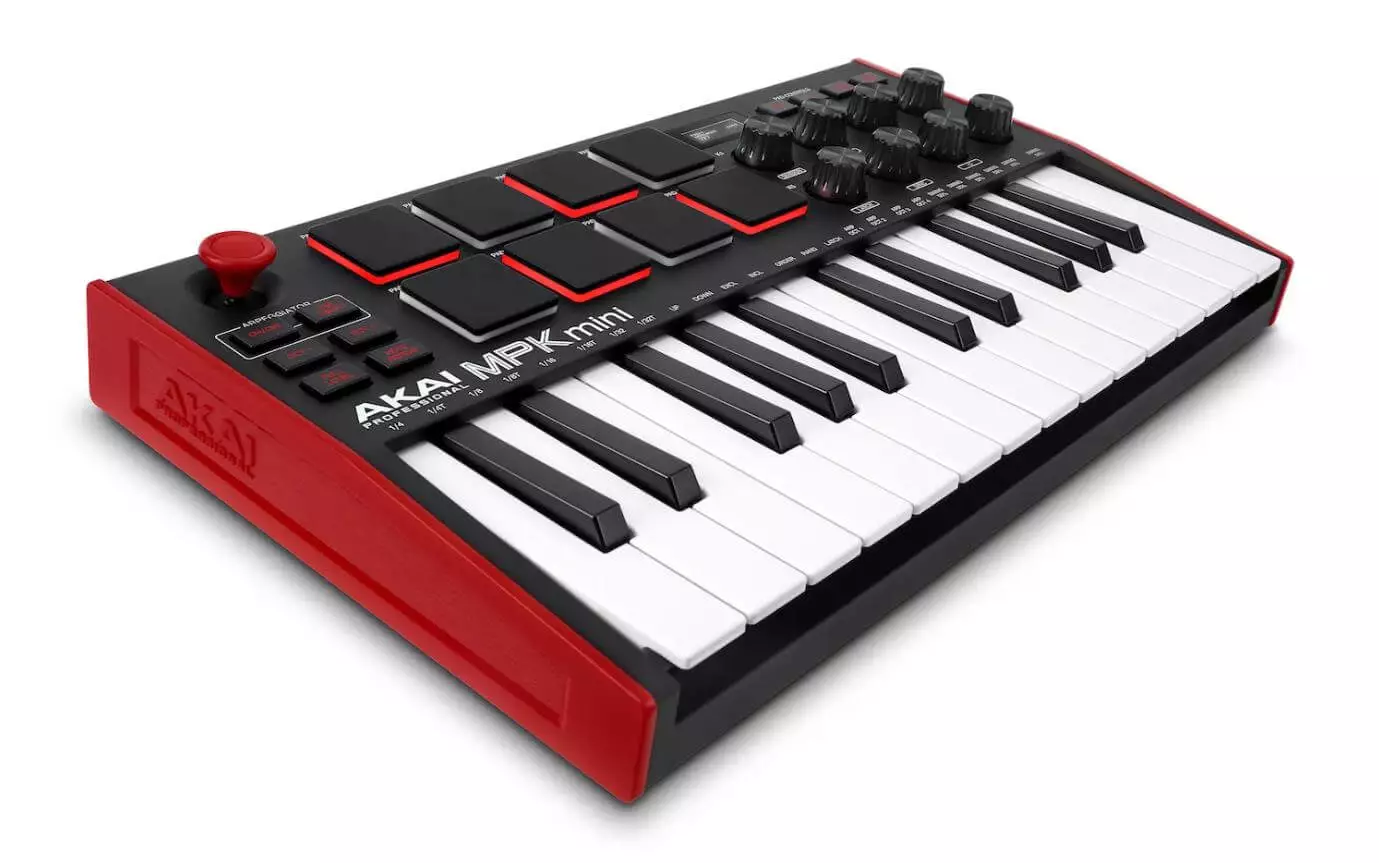
Compatibility: Mac/PC/iOS
No of Keys: 25
Key size: Mini
Key type: velocity-sensitive
Controls: Eight assignable encoders, eight MPC pads, full transport controls, 4-way joystick
Connectivity: USB
Power: Bus-powered
Software: MPC Beats, Bassline, Tubesynth, Electric, Hybrid 3, Mini Grand, Velvet
Dimensions (mm): 32 x 18 x 4 cm
Weight (kg): 750g
The Akai MPK Mini Mk3 is a great MIDI keyboard for most people, particularly those looking for a quick and easy way to add melodies, basslines and simple chords to their projects. It’s small and easy to use, with a ton of features that make it perfect for musicians of all levels.
The MPK Mini MK3 is much more than just a keyboard. It also has eight encoder knobs which can be easily mapped to any parameter of your DAW, and eight full-sized MPC style drum pads. This makes it an ideal controller for studio use or live performances.
At its heart, the Nano studio is a portable production powerhouse. Its small size makes it easy to transport, while its wealth of features and functions make it a valuable addition to any studio setup. Whether you need to record vocals, guitars, or other instruments, the Nano studio has you covered. Plus, its intuitive controls make it easy to use, even for beginners. So if you’re looking for a versatile and portable recording solution, the Nano studio is definitely worth considering.
4. IK Multimedia iRig Keys 2 Mini

Compatibility: Mac/PC
No of Keys: 25
Key size: Mini
Key type: Velocity sensitive
Controls: Volume, Octave up/down buttons, Program up/down buttons, Setup button, assignable data push encoder, 4+4 assignable knobs, Modulation
Connectivity: MIDI in/out, micro-USB, 1/8″ headphones output
Power: USB
Software: iOS SampleTank, Syntronik Pro-V Cubasis LE. Mac/PC: SampleTank 4 SE plus one of your choice from seven titles
Dimensions (mm): 32 x 14 x 5 cm
Weight (kg): 0.58kg
The Keys 2 Mini 25 is a small and affordable keyboard that has 25 mini keys. It is one of the smallest and cheapest models in the iRig Keys range, which also features keyboards with 37 mini keys and Pro (37 full-sized key) options. Mini 2 25 is small enough to place on any desktop, and it is sturdy enough to stay in place. It also features direct connectivity to iOS devices.
The keyboard has a variety of controls that you can use to customize your sound. These include the standard controls such as volume and pitch, as well as more advanced options like MIDI assignments and editing. The keyboard also has a set of program buttons, assignable rotaries, and a data knob to give you easy access to all of its features.
The keyboard is solid and well-sprung, although it may not be the player’s dream come true. There are no dedicated pitch-bend or modulation dials, but if this is important to you, there are workarounds that you can explore deeper with Edit Mode.
The Irig Keys 2 is a great keyboard controller that is a bit on the expensive side. This offers many of the same features at a smaller size and for less money. Plus, it comes with a decent software bundle.
5. Native Instruments Komplete Kontrol M32
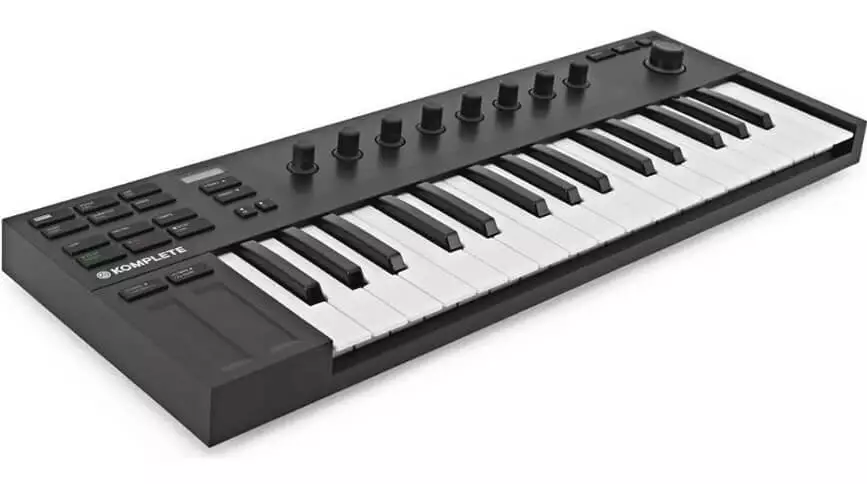
Compatibility: PC, Mac
No of Keys: 32
Key size: Mini
Key type: Velocity-sensitive
Controls: Eight touch-sensitive control knobs, two touch strips, four-directional push encoder
Connectivity: USB
Power: USB
Size: 47.5 x 16.7 x 0.5cm
Weight (kg): 1.45kg
The Komplete Kontrol A-Series is a USB 2.0 bus-powered keyboard that manages to squeeze 32 mini keys and the full complement of Komplete Kontrol controls into its tiny frame. It delivers almost the same functionality as the Komplete Kontrol S-Series (see below), making it an excellent mobile option for producers on the go.
The Komplete Kontrol M32 replaced the pitch and modulation controls with a pair of short touch strips. Also, the controller is equipped with 8 capacitive knobs, a 4d encoder, as well as numerous buttons that are incomparable in their tactile sensations. All this provides a high comfort of control, working with the operating Maschine, as well as using the interface of your DAW.
The OLED display and Smart Play features from the A-Series are also in place on the B-Series, allowing you to scale snap, chord trigger and arpeggiate with ease. As a regular MIDI controller keyboard, it also works with any other software.
The mini keys were the only downside to this keyboard for us. We found that we could live with them after some getting used to them, so if you can live with them too, this is the best portable and affordable MIDI keyboard you can buy.
6. Korg microKEY2 Air-25

Compatibility: PC, Mac, iOS
No of Keys: 25
Key size: Mini
Key type: Velocity-sensitive
Controls:Joystick, Arpeggiator button, Sustain/TAP button, Octave Shift buttons
Connectivity: USB, Bluetooth
Power: USB or batteries
Size: 39.5 x 13.1 x 0.52cm
Weight (kg): 0.67kg
The line of microKey 2 Air midi keyboards is represented by 4 models depending on the number of notes: 25, 37, 49 and 61. Each works via Bluetooth communication. Power is supplied via AA batteries or via USB.
If you’re looking for a MIDI controller keyboard that’s easy to set up and operate, the microKey 2 Air 25 is a great option. It may not have as many bells and whistles as some of its rivals, but it delivers on the basics, and plays far better than many other keyboards in its class.
7. M-Audio Oxygen 49 MKV

Compatibility: Mac/PC
No of Keys: 49
Key size: Full-sized
Key type: Velocity sensitive
Controls: 8 velocity-sensitive trigger pads, 8 assignable knobs, 9 assignable faders, transport buttons
Connectivity: USB, sustain pedal
Power: USB
Software: Ableton Live Lite, MPC Beats, Skoove and Melodics instrument learning, Air Hybrid 3 and Mini Grand instruments
Dimensions (mm): 81 x 24 x 9 cm
Weight (kg): 2.9kg
The Oxygen 49 MIDI keyboard controller is a lower-priced alternative to the M-Audio Pro 49. It has a 3-segment LED display, instead of the OLED display on the Pro, and it has 8 back-lit red pads instead of 16 multi-coloured ones. However, it still provides access to 16 sound sources from the front panel when programming.
The Oxygen 49 lacks a dedicated MIDI out port, but it does have other features that make it stand out from the crowd. These functions are mostly triggered via soft keys and via ‘secondary modes’ from the keybed itself. This makes the Oxygen 49 a great choice for those who want a powerful keyboard controller without all of the extra bells and whistles.
The Pro keyboard also includes several features that are designed to help with songwriting and composition. These include the Smart Chord and Smart Scale modes, which help you to create chords and scales that sound correct, and the arpeggiator, which can create rhythmic patterns from chords. Additionally, there is a Beat Repeat function that allows you to create stutters and repeats by triggering them from the pads.
The Oxygen Pro 49 is a great keyboard for creative professionals. It has many features that are ideal for creative work, like the ability to customise the keyboard to your own needs. It’s also very affordable, so it’s a great option for people on a budget.
8. Novation Launchkey 37 Mk3
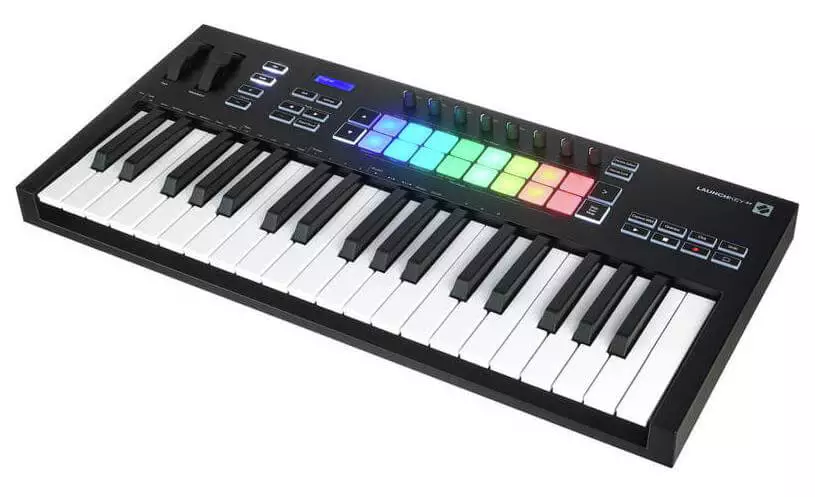
Compatibility: PC, Mac
No of Keys: 37
Key size: Full-size
Key type: Velocity-sensitive
Controls: Pitch and Modulation wheels, 16 RGB velocity-sensitive pads, 8 knobs
Connectivity: USB
Power: USB
Size: 258 x 555 x 77mm
The Launchkey MK3 keyboards from Novation have a sleek, matte-black design with low profiles. They are all similar in appearance, but come in different sizes with 25, 37, 49, and 61 keys. Regardless of size, they all have the same features and functions.
The latest Launchkeys controllers also come with great standalone Chord, Scale and Arpeggiator modes, which can be used with or without a computer. These features make the controllers ideal for use with hardware synths, too. Additionally, the controllers feature a button to activate Live’s Capture MIDI tool, as well as Push-style device control.
The latest Launchkeys controllers also come with great standalone Chord, Scale and Arpeggiator modes, which can be used with or without a computer. These features make the controllers ideal for use with hardware synths, too. Additionally, the controllers feature a button to activate Live’s Capture MIDI tool, as well as Push-style device control.
The Novation Impulse 61 is an excellent keyboard for live performances. There is little not to recommend about it, from its impressive features to its easy-to-use design. If you’re looking for a keyboard that will make your live shows easier and more enjoyable, the Impulse 61 is a great option.
9. Arturia Keystep 37

Compatibility: Mac/PC
No of Keys: 37
Key size: Mini
Key type: Velocity sensitive
Controls: Four assignable encoders, transport controls, touch strips for pitch and modulation
Connectivity: USB, clock sync, CV gate/pitch/modulation
Power: 12v DC or bus
Software: Ableton Live Lite
Dimensions (mm): 55 x 35 x 15 cm
Weight (kg): 1.6kg
The Arturia Keystep 37 is a MIDI controller that falls in between the Keystep and Keystep Pro in terms of features. It has 37 keys, which allows for more complex patterns and melodies to be played, and four assignable encoder knobs that provide visual feedback on your DAW parameters. This makes it an ideal choice for those who want a bit more control over their music production.
The sequencer is a powerful studio workhorse that can be used in many different ways. It has the ability to program steps directly onto the keyboard, as well as using the arpeggiator. This makes it versatile for different workflows in the studio. Whether you’re using it to control external hardware or modular synths, the sequencer is a great tool for any musician.
10. Native Instruments Komplete Kontrol A25
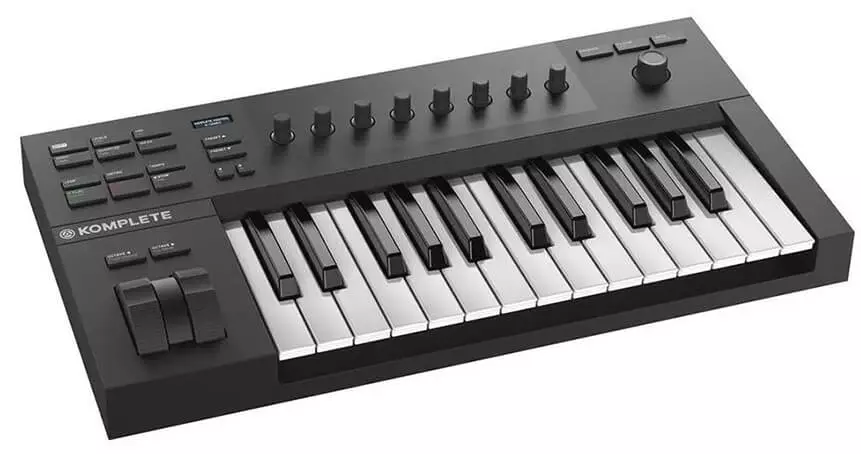
Compatibility: PC, Mac
No of Keys: 25
Key size: Full-size
Key type: semi-weighted
Controls: Pitch and Modulation wheels, transport buttons, 4-directional push encoder, eight touch-sensitive knobs
Connectivity: USB
Power: USB
Size: 48.8 x 25.7 x 8.9cm
Weight (kg): 2.4
The A-Series keyboard controllers borrow many of the best features of the S-Series, including the 4D Encoder (a joystick/rotary control/button combo) for software navigation; eight touch-sensitive knobs for plugin parameter control; beefy pitch and mod wheels; and most of the same backlit buttons, albeit laid out slightly differently. There are 3 models available with 25-, 49- and 61-keys.
The A-Series keyboards are a great value, despite the fact that they lack some features of the more expensive Maschine controllers. The most noticeable omission is the dual color LED screens, which are replaced by alphanumeric LEDs on the S25 model. Additionally, the unique per-key Light Guide LEDs are not included on the A25. However, despite these cutbacks, the A-Series still provides an excellent value proposition.
The Komplete Kontrol A25 is a great controller for those who want the full Komplete experience. It’s well-built and playable, but it’s larger than other 25-key controllers. At a great price, the Komplete Kontrol A25 is a great option for those looking for a powerful MIDI controller.
11. IK Multimedia iRig Keys I/O 49

Compatibility: PC, Mac, iOS
No of Keys: 49
Key size: Full-size
Key type: velocity-sensitive, synth-action
Controls: 2 slider strips for pitch and modulation, octave, program change and transport controls, 5 programmable touch-sensitive knobs, 8 velocity-sensitive pads
Connectivity: USB, Neutrik combo line/instrument/mic input jack with 48V phantom power, balanced stereo and headphone outputs
Power: USB or batteries
Size: 69.3 x 20.8 x 6.5cm
Weight (kg):2.18
The IRig Keys I/O MIDI controller keyboard and audio interface is designed for musicians who want the most compact setup possible. Despite its small size, it doesn’t sacrifice playability, and comes with a great selection of software included.
This model is equipped with lightweight keys with a smooth movement and minimal lateral movement. There is also a built-in audio interface operating at 24-bit/96 kHz while maintaining high sound quality.
The Irig Keys I/O 49 is a great MIDI controller for someone who wants something small and affordable. It has all the features you need for basic recording and MIDI control, and it comes with a great software bundle that makes it a great value.
12. Nektar Impact LX88+ MIDI keyboard
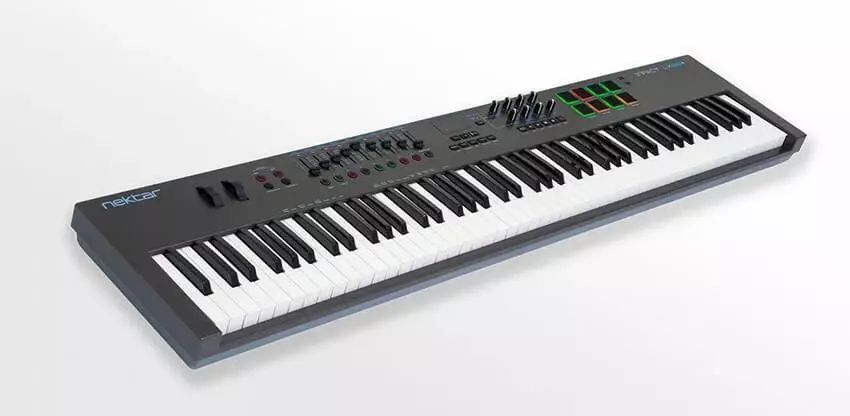
Compatibility: PC, Mac, iOS
No of Keys: 88
Key size: Full-size
Key type: Velocity-sensitive, semi-weightedControls: 8 potentiometers, 9 faders, 9 assignable buttons, 6 transport buttons, 8 velocity-sensitive pads
Connectivity: USB, MIDI Out port, 1/4-inch TS jack footswitch input
Power: USB or mains
Size: 127.6 x 27.9 x 8.9cm
Weight (kg): 8.2
The Impact LX88+ keyboard controller is a great option for anyone looking for a full-sized MIDI controller. It features 88 semi-weighted keys, as well as nine sliders, nine buttons, eight knobs, and eight pads for controlling your DAW. It’s also USB-powered, making it easy to take with you wherever you go.
Despite its many features, the LX88+ is a reasonably compact and light keyboard that is portable. The keys feel good and the mechanical noise is low. While it may not be suitable for everyone, 88-key users may find it lacks some features they are looking for. However, at this price it is a bargain and well worth considering.
13. Arturia Keystep Pro
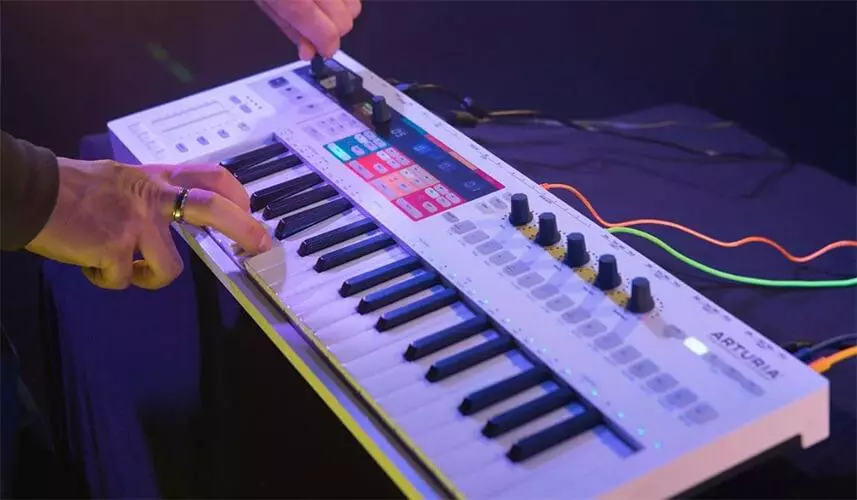
Compatibility: PC, Mac, iOS
No of Keys: 37
Key size: Slim
Key type: Velocity and aftertouch sensitive
Controls: Four-track controller/sequencer, with arp and drum sequencing modes. I, 4x CV voices w/ pitch, gate and mod/velocity outs, clock in/out/reset
Connectivity: USB, sustain in, speaker and line output
Power: USB or mains
Dimensions (mm): 589 x 208 x 38
Weight (kg): 2.7
The KeyStep Pro is a MIDI controller that combines the features of the BeatStep analog and digital sequencers with a 37-note keyboard. This makes it better suited for melodic work than the BeatStep, which has fewer keys. The KeyStep Pro can be used to sequence analog and digital instruments, as well as control software instruments.
KeyStep Pro is a powerful 4-channel sequencer that can record up to 64 step sequences, each of which can include up to 16 notes. Tracks 2, 3 and 4 come with arpeggiators, while track 1 is a drum sequencer with 24 parts. With so much power under the hood, KeyStep Pro is capable of creating complex sequences with ease.
The Arturia Keystep Pro controller is a great option for those who need a versatile device for sequencing tasks and hardware control. It’s compact size may be a drawback for some users, but it offers great flexibility and modularity for musicians who want to get the most out of their hardware.
14. Arturia KeyLab 49 MkII MIDI keyboard

Compatibility: PC, Mac
No of Keys: 49
Key size: Full-size
Key type: Velocity-sensitive with aftertouch
Controls: 16 RGB-backlit performance pads, control bank with 9 faders and 9 rotary knobs
Connectivity: Expression, sustain, CV/Gate, MIDI, USB and 3 assignable auxiliary pedal inputs
Power: USB mains with optional adapter
Size:79.3 x 29.7 x 5.3cm
The KeyLab MkII is a flagship controller keyboard from Arturia, designed to provide deep integration with the bundled Analog Lab 3 software. It is available in 49- and 61-key versions, in black or white. The keyboard and pads are bolstered by DAW controls and a range of other features that make the MkII a very different unit from the KeyLab Essential. With a higher pricetag, the MkII is aimed at more upmarket users.
The Pro-Feel keyboard has excellent pressure sensitivity across its entire speed range, making it ideal for expressive performance. The metal case provides additional durability and safety. The pitch and modulation wheels are lighter and more responsive, making it easy to create nuanced performances. KeyLab MkII is easy to use with three modes of operation: DAW, Analog Lab and User with customizable presets.
The KeyLab MkII is not only a great controller for performance and DAW control, but also a powerful synth editor. It has CV connection capabilities as well as standalone operation, making it a great value for the price.
15. Novation 49 SL MkIII

Compatibility: PC, Mac
No of Keys: 49
Key size: Full-size
Key type: semi-weighted, synth-style, velocity-sensitive
Controls: Pitch and Modulation wheels, 16-full colour RGB backlit velocity-sensitive drum pads, page and scene launch buttons, 8 continuous rotary knobs, 8 sliders, 6 transport controls, octave/transpose buttons, track buttons, 5 RGB TFT screens
Connectivity: USB, MIDI Out/Out2/Thru, Sustain and Expression pedal, Footswitch pedal, CV/Gate/Modulation 1 and 2, Clock out
Power: Mains power
Size: 81.7 x 30 x 10cm
The Novation SL MkIII is a great controller for your DAW, but it can do much more than that. With its eight-channel onboard sequencer and multiple forms of digital and analogue output, the SL MkIII can be adapted to fit your specific needs. However, configuring it can be a bit of a hassle, so take some time to get everything just right.
The SL MkIII is a powerful controller that offers a lot of flexibility for interfacing hardware and software. It allows you to sequence and control analogue hardware, MIDI-equipped instruments, plugins and your DAW all from one interface and clock source. This makes it an excellent choice for anyone looking for a versatile workflow.
16. Native Instruments Komplete Kontrol S61 MkII

Compatibility: PC, Mac
No of Keys: 61
Key size: Full-size
Key type: velocity-sensitive with aftertouch
Controls: Pitch and Modulation wheels, touch strip, two high-res colour screens, Light Guide, 4-directional push encoder
Connectivity: USB
Power: USB
Size:100 x 29.7 x 8.4cm
Weight (kg): 6.55
The Komplete Kontrol S61 MkII provides the ability to control NI Komplete instruments and third-party plug-ins that support the NKS standard. It is equipped with two high resolution screens, has 17 additional function buttons, and is tightly integrated with DAW and Maschine, allowing you to manage your projects from the hardware.
The Komplete Kontrol S61 MkII has a Fatar keybed and Light Guide, and we welcome the arrival of proper pitch and mod wheels rather than touchstrips. That said, a single horizontal touchstrip is supplied and can be used for additional expression. If you liked the idea of Komplete Kontrol the first time around, the good news is that there’s even more to like about it now – the hardware itself has been improved.
The Komplete Kontrol MkII is an amazing piece of hardware that can do so much more than you might think from just looking at it. With better visual feedback and deeply integrated workflows, it makes use of the Komplete software package to its fullest potential. If you’re already familiar with Komplete, there’s no other hardware that will help you work with it as musically as the MkII.
17. Roland A-88MKII
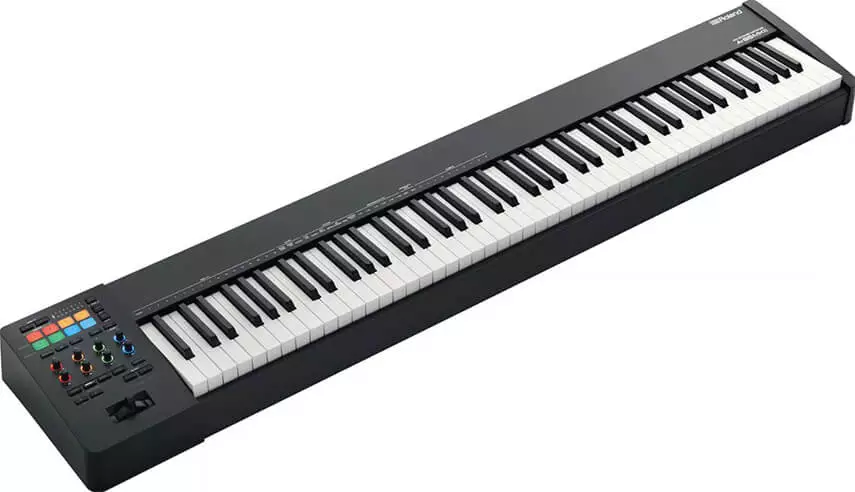
Compatibility: Mac/PC
No of Keys: 88
Key size: Full-sized
Key type: Velocity sensitive with Escapement and Ivory Feel
Controls: 8 pads, 8 knobs, Pitch Bend/Modulation lever, 2 assignable buttons, 3 x pedals
Connectivity: 3 x TRS pedal jacks, MIDI in/out, USB Type-C, DC
Power: USB or external PSU (not supplied)
Software: Control software and Standard MIDI File player
Dimensions: 143 x 27 x 12 cm
Weight (kg): 16.3
The Roland A-88MKII is a long-awaited update to the company’s much loved A-88 full-size piano action MIDI keyboard. At 16kg, it’s not too heavy for live use, and its compact footprint is good news if you’re using it in the studio.
A 88MKII has been overhauled with new backlit pads and knobs, making it easier to use in low-light settings. Two assignable Control Change buttons have also been added, as well as a Transpose and Octave selector. Additionally, Velocity Curve options are available to customize the keyboard’s sensitivity, and an onboard arpeggiator can be used to create complex rhythmic patterns. Pitch-bend and modulation are handled by a combination lever, and the keyboard can operate in up to three layers or three split zones. The A 88MKII is MIDI 2.0 ready, so it can take advantage of the advanced features that this communication protocol offers.
The A88MkII has a great design, with Ivory Feel keys, 3-sensor key detection and key-specific progressive hammer action. This all delivers the feel of a real piano, making it a very capable and competitively priced unit. Its winning feature is that the piano action is class-leading at this price point. Being future-proofed with MIDI 2.0 support is also great.
18. ROLI Lumi Keys Studio Edition
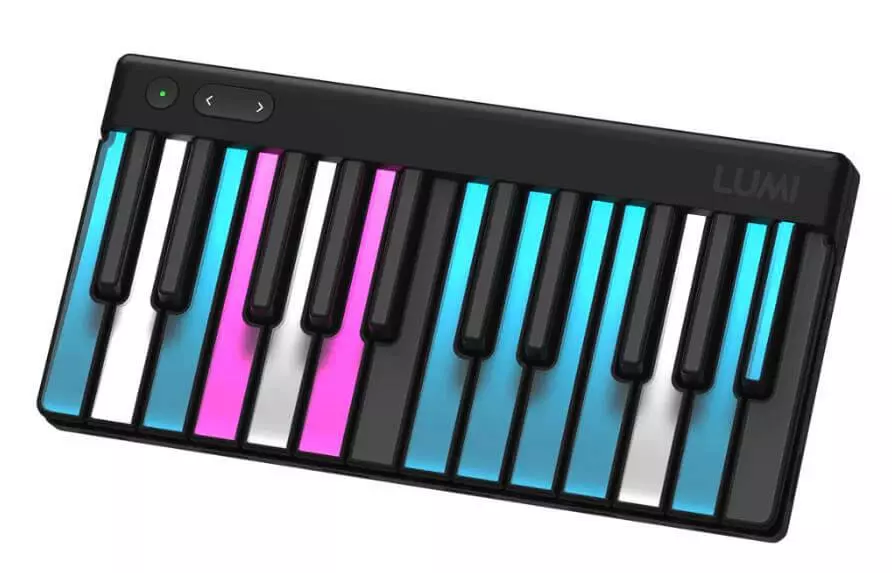
Type: MPE keyboard controller
Keys: 24
Connectivity: USB
The Lumi Keys Studio is a keyboard that brings new dimensions to producer arsenals. It pairs the MPE-enabled expressivity of a Seaboard with the layout of a traditional keyboard, making it an ideal tool for producers of all levels of experience.
The Studio Edition is a great way to add MPE capabilities to your hardware setup. With its MIDI and CV outputs, you can use it to control any synthesizer or drum machine that accepts MIDI or CV input.
The illuminated keyboard itself is a useful tool, presenting information in a clear and intuitive way. The right keys of a scale are highlighted, as well as notes being played by the arpeggiator. This makes it easy to see what is happening with the music you are creating.
A controller can be a great addition to your music making arsenal, but it does have some limitations. Its short note range, for example, covers just two octaves. If you want to play notes that are higher or lower than that, you’ll need to link a second unit to the controller for the full range. Additionally, the controller’s sounds may not be as rich and full-fledged as those of some other instruments. But with its affordable price tag, the controller is still a great option for beginning or experienced musicians alike.
19. M-Audio Keystation 88 MK3

Type: Keyboard controller with semi-weighted keys
Keys: 88
Connectivity: USB, 9V DC 500mA power supply (sold separately) 1 x 1/4″ TS (sustain pedal), 1 x 1/4″ TRS (expression)
The Keystation 88 is a great way to get your hands on an 88-key controller, and the full-sized, semi-weighted keys make it a great choice for serious musicians.
The M-Audio Keystation 88 MK3 has a lot to offer musicians and producers alike. Even though it doesn’t have features such as aftertouch or performance pads, DAW controls are included – which can be remapped. This means you won’t have to reach over to the keyboard and mouse every time you want to lay down a take. In short, the Keystation 88 MK3 is a great option for anyone looking for a reliable, no-fuss MIDI controller.
20. M-Audio Oxygen MKV 61
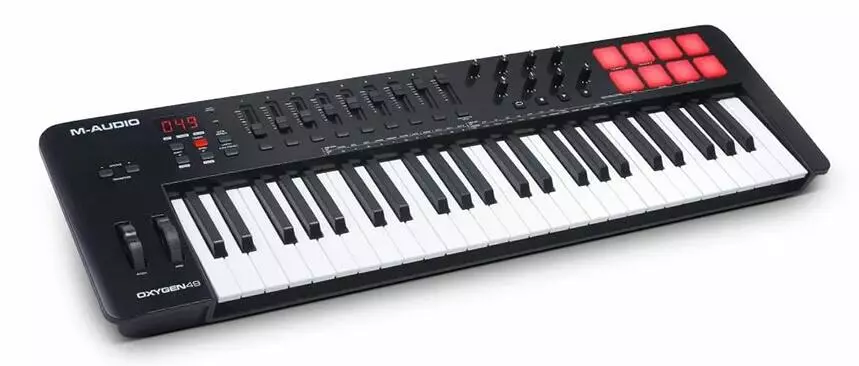
Type: Keyboard controller
Keys: 61
Connectivity: USB, 1 x 1/4” (sustain pedal)
M-Audio’s popular Oxygen controllers have now reached their fifth iteration, and the MKV 61 is the largest and most feature-rich model. This update brings new DAW integration, Smart Chord/Scale and an arpeggiator, while still keeping the design light and robust. Whether you’re a beginner or a seasoned pro, the MKV 61 will give you all the tools you need to take your music production to the next level.
The five-octave keyboard on the Novation Peak is well-suited to percussive sounds such as drums and synth stabs, with its non-weighted keys. It also has eight backlit pads, eight knobs and nine faders to bolster its production capabilities.
The Oxygen MKV 61 controller has a wide note range, which makes it a great tool for composition. It also has smart chord and scale features, making it a great value for the price.
21. Nektar Impact GX Mini
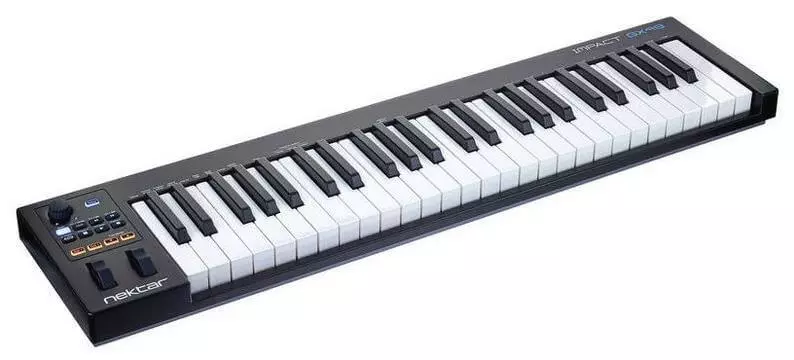
Type: Keyboard controller
Keys: 25
Connectivity: USB, 1 x 1/8″ (sustain pedal)
Nektar’s Impact GX Mini is small and easy to customize, making it a great option for people with specific workflows. Even better, it has a clever workaround to moving through more octaves than you see on its hardware.
This keyboard controller is perfect for musicians who are looking for a compact and lightweight option. The velocity sensitive mini keys make it easy to create expressive performances, and the modulation joystick can be assigned with MIDI to add dynamic control to your music. The Part Two performance feature also lets you temporarily transpose the keyboard up or down an octave, making it easy to play in different keys.
DAW controllers offer a wide range of controls that can be assigned to MIDI messages. This includes transport controls, track navigation controls, and more. This allows you to customize your workflow to match your needs.
23. CME XKey 25
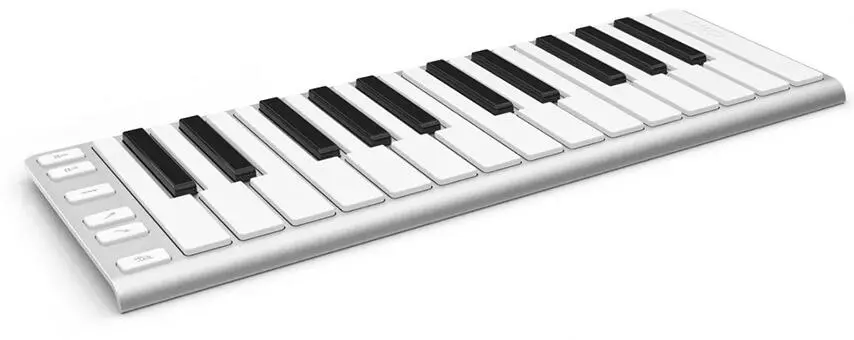
Type: Keyboard controller
Keys: 25
Connectivity: Micro USB
The XKey 25 MIDI keyboard from CME is the perfect companion for composer and performers on the go. It’s lightweight and robust aluminum design makes it easy to take with you wherever you go, and its simple layout lets you get to work quickly, without any unnecessary distractions. Whether you’re on your way to work or out for a day in the park, the XKey 25 is the perfect way to lay down some ideas.
The CME XKey 25 keyboard has a unique feel that is unlike anything else on this list. Its full-size velocity-sensitive keys feature polyphonic aftertouch for expressive modulation, making it ideal for dreamy, evolving pads. Additionally, the keyboard has pressure-sensitive pads for pitch bend and modulation, as well as an octave up/down button and a Sustain button.
The XKey is a great MIDI controller because it is USB compliant and easy to use with a variety of music-making platforms. It can also be used wirelessly, making it a versatile option for any musician.
23. Nektar Impact GX49/61

Type: Keyboard controller
Keys: 49
Connectivity: USB (MIDI and power), Sustain/Footswitch input
Nektar’s Impact GX49 is a great option for artists and producers on a budget. With 49 velocity-sensitive keys, it provides plenty of room to play, and the eight buttons for DAW control can send primary and secondary messages for a total of 14 controllable parameters. This makes it easy to get the most out of your music-making software.
If you want to take your music production to the next level, you need a DAW controller. The Nektar Impact GX49/61 is a great option, especially for its price. It’s easy to set up – just install the DAW template and you’re ready to go. The transport controls will map automatically to your DAW, so you’ll be able to work faster and more efficiently.
24. M-Audio Keystation 49/61 MK3

Type: Keyboard controller
Keys: 49 or 61
Connectivity: USB (MIDI and power), Sustain input
The Keystation 49 Mk3 MIDI keyboard is a great option for live performances and general control. It features 49 velocity-sensitive keys with natural-feeling action, as well as a volume fader, ergonomically designed pitch and mod wheel, and a selection of transport controls. The controller is durable and lightweight, with connectivity for a sustain pedal. This makes it an excellent choice for anyone looking for a simple but powerful MIDI keyboard.
Ableton Live Lite are included, providing a taste of two popular DAWs. Additionally, three AIR virtual instruments are included: Mini Grand, Velvet and Xpand!2. These versatile tools can help you create music in a variety of styles.
25. NI Komplete Kontrol A49
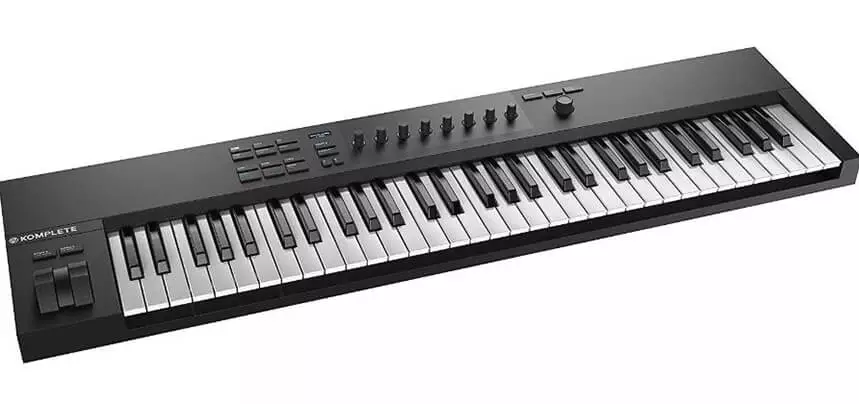
Type: Keyboard controller
Keys: 49
Connectivity: USB (MIDI and power), TRS pedal input, assignable to sustain
The Kontrol A49 is a great option if the Komplete Kontrol M32 isn’t quite big enough for you. It has the same software library with Monark, The Gentlemen, Reaktor Prism and more from Maschine Essentials. However, the A-series Kontrol keyboards have a few more encoders and controls to command your DAW and virtual instruments. If you’re performing with the Native Instruments NKS plug-ins, the A49 gives you a real hands-on experience.
The Komplete Kontrol S49 keyboard controller is designed to provide a seamless integration between hardware and software in the ever-growing NKS world of instruments and effects. It delivers total control over its best bits, and even makes an attempt at controlling your DAW. But Komplete Kontrol is really about total hardware and software plug-in integration, breaking down any barriers between the two. This ultimately provides a more efficient workflow for music production.
26. Keith McMillen QuNexus

Type: MPE mini keyboard controller
Keys: 25
Connectivity: Micro USB (MIDI and power), CV/Gate In/Out, Pedal input/CV1-2 in (3.5mm)
The Keith McMillen Instruments QuNexus is a unique and quirky MIDI controller. It features pressure- and tilt-sensitive pads with polyphonic aftertouch, backlit keys, and four function buttons. The pitch bend is achieved with a pressure-sensitive pad, and the Octave Up/Down buttons also have a secondary function. This controller is particularly useful in a poorly lit environment. You can map the QuNexus to toggle whichever parameters you like in your DAW.
The main advantage of QuNexus is its long service life and wide range of possible connections. Its design is spill-resistant, and it also does not have protruding handles that can be cut off in a packed backpack. Power comes from the bus through a plug-and-play computer connection. QuNexus can be used as a controller for controlling hardware synths and effects. It has 3 TRS 3.5mm jacks for Gate and CV. Can also be connected to a 5-pin MIDI DIN connector with a KMI expander sold separately.
27. Alesis V61

Type: Keyboard controller
Keys: 61
Connectivity: USB (MIDI and power), Sustain input
The Alesis V61 is a great keyboard for people coming from a composition background or anyone who hates octave shift buttons. At only £199, the main selling point of this keyboard is the 61 velocity-sensitive full-size keys with pitch and mod wheels. You also get eight velocity-sensitive pads which are great for triggering samples during a performance or toggling parameters on and off. There are four additional pots and four buttons which you can custom map, making this keyboard primed for studio and stage use. Granted, the pitch and mod wheels are a little on the small side, but if you can get past that then the V61 could be a great choice for you.
The Alesis V61 comes with a range of features that make it perfect for any musician. Along with Ableton Live Lite and AIR Music Technology’s Xpand!2 synth, the V61 is slim and easy to transport, making it the perfect choice for anyone who wants a great performance-based keyboard. Whether you’re just starting out or are a more experienced musician, the V61 is definitely worth considering.
28. Nectar SE49
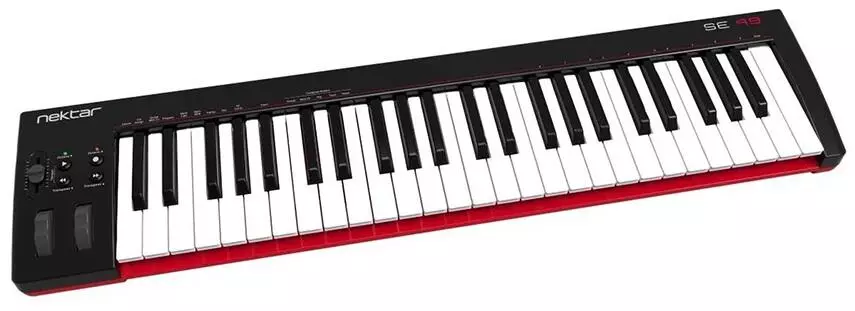
The Arturia KeyStep is a great controller, but it has some limitations. The 32-key limit means that I only have 2.5 octaves to work with, which can be limiting for complex parts or pieces. However, the KeyStep is still a great option for simpler parts or pieces.
The Nektar SE49 is a great keyboard for those who are looking for something with a smaller number of keys. Its playability and simple control scheme make it a great option for those who are just starting out or need a portable keyboard.
Nektar controllers were designed to provide an ideal experience for using DAWs, specifically Reason. They are closely integrated with the software, allowing you to operate without even glancing at your computer screen. This makes them perfect for studio use, as you can focus on your music instead of your equipment.
Nektar’s SE49 keyboard is a great choice for DAW enthusiasts who need a high-quality instrument with precise focus. However, it may not be the best option for a general consumer. Nektar’s keyboards are always well-made, and the SE49 is no exception. It provides an excellent experience for anyone who wants to use a DAW.
It’s worth noting that there is much debate surrounding the best affordable MIDI keyboard controller. The Roland A-49 is a slightly more expensive option that’s a bit older, but it is well praised for offering good value for money. Some people prefer the feel of the keys on the Nektar Impact LX49+, which is another affordable option. Ultimately, it comes down to personal preference.
The M-Audio Keystation series of keyboards lag behind in terms of playability when compared to some of the other brands available, but they do include 5-pin MIDI support. This can be an important feature for those who want to use more advanced MIDI gear.
If you’re looking for a MIDI keyboard that can handle modules as well, you might want to consider the Keystation. It has USB MIDI capabilities, which means you can use it with your computer or other devices.
The SE49 lacks some important controls, such as a fader, pitch and mod wheels, and 4 buttons. This can make it difficult to use effectively for some tasks. Additionally, there are no pads on this keyboard, which can be a downside for some users.
The SE49 has a great unweighted keyboard, which is only beaten by the Novation Impulse’s semi-weighted keys.
The SE49 feels like the best option in this price range. I can play piano, synth, and organ without much issue. It just feels better than other options.
The Keystation’s keybed is weak, which can be a problem when trying to play glides and glissandos. The Roland A-49, while feeling good with synths, doesn’t feel as good with those types of sounds.
The SE49’s keys are nearly perfect, but aftertouch would have made them perfect. Unfortunately, this feature doesn’t exist on the competition’s keyboards at this price point. However, Nektar is still a great choice for a keyboard controller.
The controls feel high-quality, even though they are limited in what they can do. The pitch bend and mod wheels are precise and feel like they will last a long time. This was unexpected, but a pleasant surprise.
The SE49 is a great MIDI controller for those on a budget. It has a lot of features for its price, and it performs well. The biggest pro of the SE49 is its price. This is one of the most affordable 49-key MIDI controllers out there, and it thankfully hits well above its weight class.
The SE49 is a great MIDI controller for those on a budget. It has a lot of features for its price, and it performs well. The biggest pro of the SE49 is its price. This is one of the most affordable 49-key MIDI controllers out there, and it thankfully hits well above its weight class.
29. Roli Seaboard

Roli is a company formed to tackle the issue of creating music without knobs or buttons head-on. Their products, from the Roli Lightpad Block to the Roli Seaboard, don’t have any knobs or buttons. This makes it difficult for people who are just starting out with making music to get started, as they have to learn how to use an unfamiliar interface. However, this also allows for a much greater range of expression, as even the slightest touch can create a change in sound.
Aftertouch is a simple concept that can add extra dimensions to enhance performance capabilities. By using aftertouch, you can create new sounds and add expression to your music. With aftertouch, you can control the volume, pitch and other parameters of your sound. Aftertouch is a powerful tool that can help you create unique sounds and expressive performances.
The idea behind a capacitive keyboard is that you would be able to control different parameters of your synthesizer by moving your fingers up and down on the keys. This would allow for a more expressive playing style, allowing you to bend pitches and control the cutoff frequency of the synth’s filters with ease.
If you’ve ever used Korg’s famous Kaoss pads, the Seaboard feels like that, but in keyboard form. The Seaboard is a unique piece of equipment that allows for something quite special. With its soft silicone keybed, you can create expressive sounds and perform dynamic music with ease.
Roli keyboards are designed for touch-based playing, and come with their own software plugins for the best sound possible. While these plugins can be complicated to use at first, the sounds they create are well worth the effort. Whether you’re a beginner or an experienced player, a Roli keyboard is a great investment that will open up new possibilities for your music.
The price is a big issue for many people looking at the Seaboard Block. It’s many times more expensive than other 25-key controllers, and even more expensive than the 49-key Seaboard Rise. This is a big investment for most people.
What key size do you need?
If you’re looking for a MIDI controller that is simple to use and easy to transport, a model with mini keys may be the best option for you. These controllers are smaller in size and often less expensive than their full-size counterparts, making them a great option for those on a budget. Additionally, mini keys can be just as responsive and easy to play as larger keys, making them a great choice for any musician.
There are a variety of different digital keyboard options on the market, each with its own unique benefits and drawbacks. If you’re coming from a background playing other instruments such as the piano or keyboard, you may find that you prefer the traditional playing experience offered by full-sized weighted keys. Thankfully, there are options for everyone, and there are keyboards on the market that offer both full-sized weighted keys and portable portability. So if you’re looking for a keyboard that can provide the best of both worlds, be sure to keep this in mind when shopping.
How many keys is enough?
When looking for a MIDI keyboard, it’s important to consider the number of keys that are available. The best MIDI keyboards have octave shift buttons, which allow you to access the full range of note pitches, even from a 25-key device. If you’re an advanced player or want to learn how to play two-handed, you’ll need a keyboard with more keys. However, if you’re just starting out, a smaller keyboard will work fine.
What you need to know about connectivity
All of the controllers in this guide can be powered via the USB port, and if you want to play proper piano parts, a sustain pedal input is a must. If you’re looking for a MIDI controller that has a MIDI output, make sure that it has a mini jack TRS MIDI output. This type of output is becoming more popular and offers the same functionality as a traditional 5-pin MIDI out port. If you’re working ‘in-the-box’ on a single computer or laptop, you likely won’t need a MIDI output unless you have some hardware MIDI synths to connect it to.
Understanding DAW Integration
If you’re looking to improve your workflow and get more hands-on control over your music production, adding a remote transport control system to your setup can be a huge help. Transport controls – like play, pause and record arming – are essential for most music production tasks, so being able to manage them from your keyboard or MIDI controller instead of your computer can save you a lot of time and frustration.
There are many different controllers available that offer deep integration with popular DAWs, so finding one that fits your needs shouldn’t be too difficult. Once you have it set up, you’ll be surprised at how much easier it is to work with your software instruments and effects.


